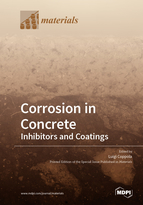Corrosion in Concrete: Inhibitors and Coatings
A special issue of Materials (ISSN 1996-1944). This special issue belongs to the section "Construction and Building Materials".
Deadline for manuscript submissions: closed (31 July 2021) | Viewed by 21784
Special Issue Editor
Interests: durability and sustainability of cementitious materials; admixtures and additives for concrete; alternative binders and aggregates; cement-based repair materials
Special Issues, Collections and Topics in MDPI journals
Special Issue Information
Dear Colleagues,
In a new era of sustainable development, durability is a foundamental topic in the concrete sector, with remarkable consequences on environmental and economical issues. Production of high performance concretes with a low water to cement ratio and appropriate cements and admixtures represents a mandatory condition to assure durability of reinforced concrete structures. However, the crack tendency of concrete and exposure to severe conditions could require additional technical solutions to guarantee the durability of reinforced concrete elements. Corrosion inhibitors and coatings could represent a suitable solution to face corrosion and deterioration even in these aggressive environments or in the presence of cracks. Corrosion inhibitors, applied on the surface of the reinforced concrete (migranting corrosion inhibitors) and/or added as concrete ingredients, represent a valid technique to mitigate corrosion risk in both new and existing structures. Similarly, coatings can be employed to prolong the service life of reinforced concrete structures exposed to air (CO2-induced corrosion of rebars), seawater or deicing salts (chloride-induced corrosion of steel bars), as well as concrete structures subjected to an acid attack.
This Special Issue aims to add evidence to the scientific progress achieved in the research and development of corrosion inhibitors and coatings for concrete.
Topics of interest include the following:
- Corrosion inhibitors as cementitious mixture ingredients for reinforced concretes;
- Migranting corrosion inhibitors;
- Coatings to prevent CO2-induced corrosion of steel bars;
- Coatings to enhance durability of structures exposed to chloride-induced corrosion;
- Coatings for concrete elements subjected to acid attack;
- Case history and applications.
Guest Editor
Manuscript Submission Information
Manuscripts should be submitted online at www.mdpi.com by registering and logging in to this website. Once you are registered, click here to go to the submission form. Manuscripts can be submitted until the deadline. All submissions that pass pre-check are peer-reviewed. Accepted papers will be published continuously in the journal (as soon as accepted) and will be listed together on the special issue website. Research articles, review articles as well as short communications are invited. For planned papers, a title and short abstract (about 100 words) can be sent to the Editorial Office for announcement on this website.
Submitted manuscripts should not have been published previously, nor be under consideration for publication elsewhere (except conference proceedings papers). All manuscripts are thoroughly refereed through a single-blind peer-review process. A guide for authors and other relevant information for submission of manuscripts is available on the Instructions for Authors page. Materials is an international peer-reviewed open access semimonthly journal published by MDPI.
Please visit the Instructions for Authors page before submitting a manuscript. The Article Processing Charge (APC) for publication in this open access journal is 2600 CHF (Swiss Francs). Submitted papers should be well formatted and use good English. Authors may use MDPI's English editing service prior to publication or during author revisions.
Keywords
- corrosion in reinforced concrete structures
- corrosion inhibitors
- coatings for concrete
- durability of reinforced concrete structures







